Factor Investing in Micro & Small Caps
Treasure Hunting in the Wild West of Equity Markets
October 2018. Reading Time: 10 Minutes. Author: Nicolas Rabener.
SUMMARY
- Micro caps are commonly perceived as highly risky, but potentially also highly rewarding
- Smalls caps generate more attractive risk-return ratios than micro caps on index level
- Focusing on factors improves risk-adjusted returns across market cap segments
INTRODUCTION
FAANG stocks like Apple (AAPL) are covered by dozens of highly trained financial analysts. Galaxy Gaming (GLXZ), on the other hand, is followed by exactly zero analysts.
Galaxy Gaming who?
Galaxy Gaming, which produces table games and betting platforms for the casino industry, has a market capitalization of $50 million and trades over the counter (OTC). Unfortunately for such companies, analyst coverage of US stocks has been steadily decreasing since the 2000s due to tighter Wall Street regulations, among other factors.
But the lack of analyst coverage might offer alpha-generating opportunities. Could the less-covered areas of the equity markets be worth an extra look?
Although analyzing thousands of micro- and small-cap stocks by hand is not a sensible strategy, investors can apply systematic frameworks to uncover hidden gems. So does factor investing in micro- and small-cap stocks in the United States offer any additional alpha?
METHODOLOGY
To find out, we divided the US equity market into three segments based on market capitalization. Together these three segments approximate the Russell 3000 universe:
- Micro caps include about 800 stocks, each with $100 million to $500 million in market capitalization.
- Small caps feature about 400 stocks with $500 million to $1 billion in market capitalization.
- Mid and large caps have market capitalizations in excess of $1 billion and number about 1,800 stocks in total
We created market cap-weighted and equal-weighted indices as well as three equal-weighted factor portfolios composed of the top 10% of stocks ranked by each factor. We define Value as a combination of price-to-book and price-to-earnings multiples and Quality as a combination of return-on-equity and debt-over-equity (read Quality Factor: How To Define It?). Momentum is measured by the performance over the last 12 months, excluding the most recent month. The indices are rebalanced quarterly and the factor portfolios monthly.
Transaction costs are 1% for micro caps, 0.5% for small caps, and 0.1% for mid and large caps. Since shorting micro- and small-cap stocks is expensive and frequently impossible, we focused on long-only portfolios.
FACTOR INVESTING IN MICRO CAPS
The small-cap companies generally come in two varieties: a small number of firms that recently went public and a large cohort whose businesses are in decline.
The characteristics of the universe are reflected by the performance of the Quality portfolio, which successfully reduces exposure to less healthy companies by focusing on profitable and lowly levered stocks. Cheap companies also outperformed the indices, while the Momentum portfolio underperformed post-2009, reflecting the severe Momentum crash that followed the financial crisis.
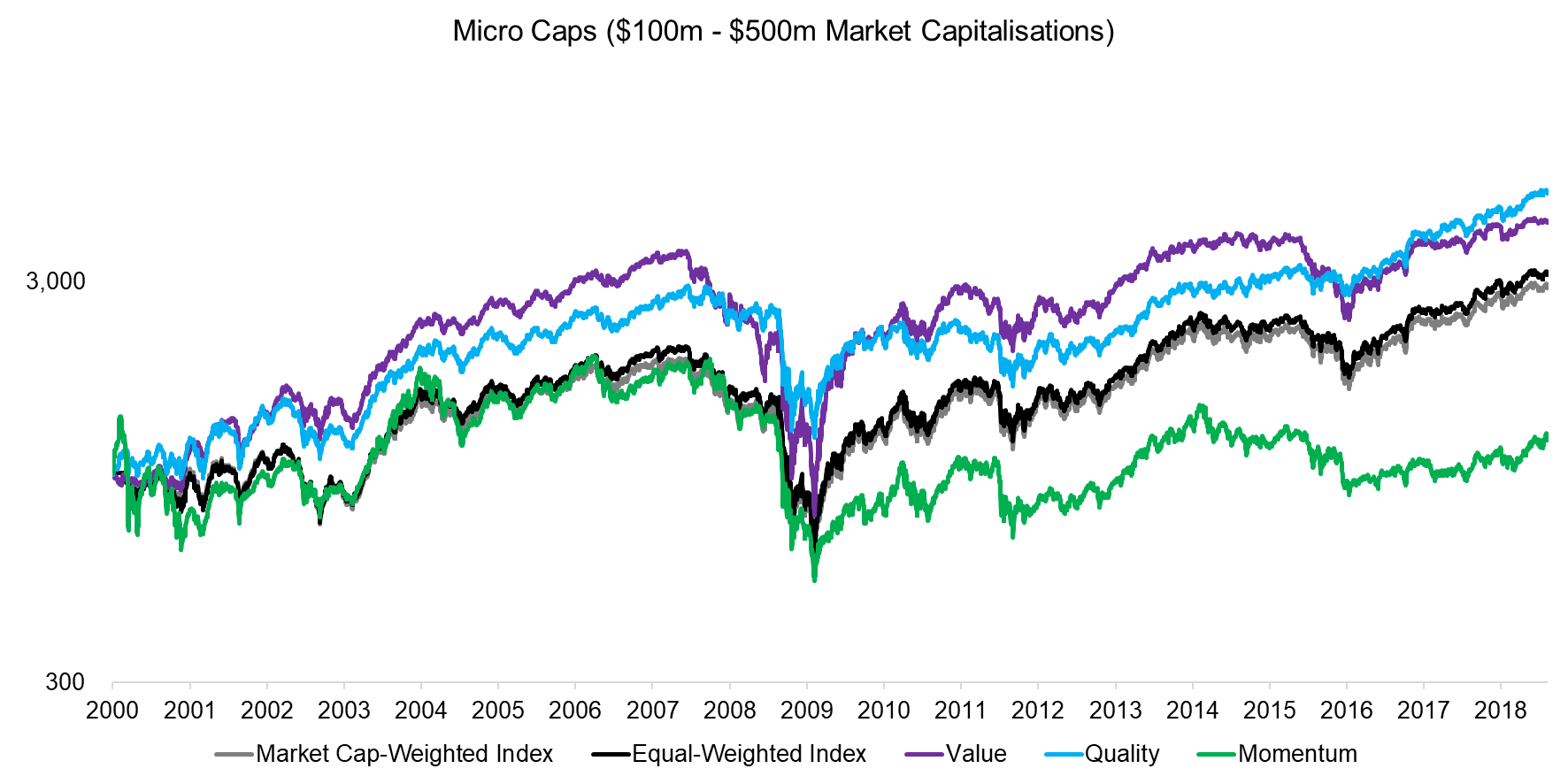
Source: FactorResearch
FACTOR INVESTING IN SMALL CAPS
Small caps generated more attractive returns than micro caps from 2000 to 2018. Only the Value portfolio outperformed the indices, with most of the outperformance coming between 2000 and 2003, when the tech bubble imploded. Cheap stocks were unpopular during the tech bubble but rebounded significantly thereafter (read Size Factor).
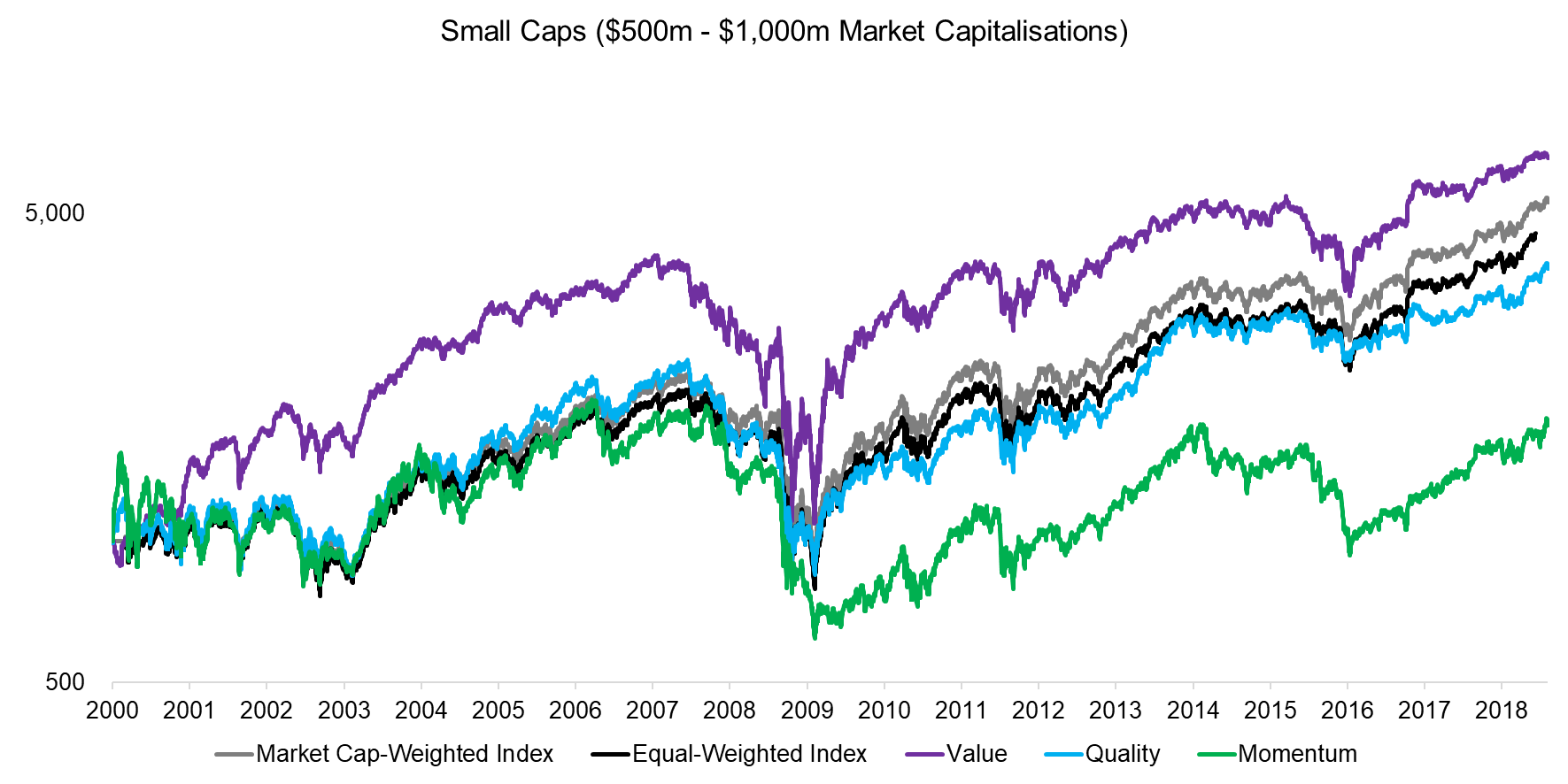
Source: FactorResearch
FACTOR INVESTING IN MID & LARGE CAPS
The mid-and large-cap universe is composed of mostly successful companies. As with micro and small caps, only cheap companies outperformed the indices. It is worth noting that the factor performance across market caps is relatively homogenous, which partially depends on the starting point of the analysis.
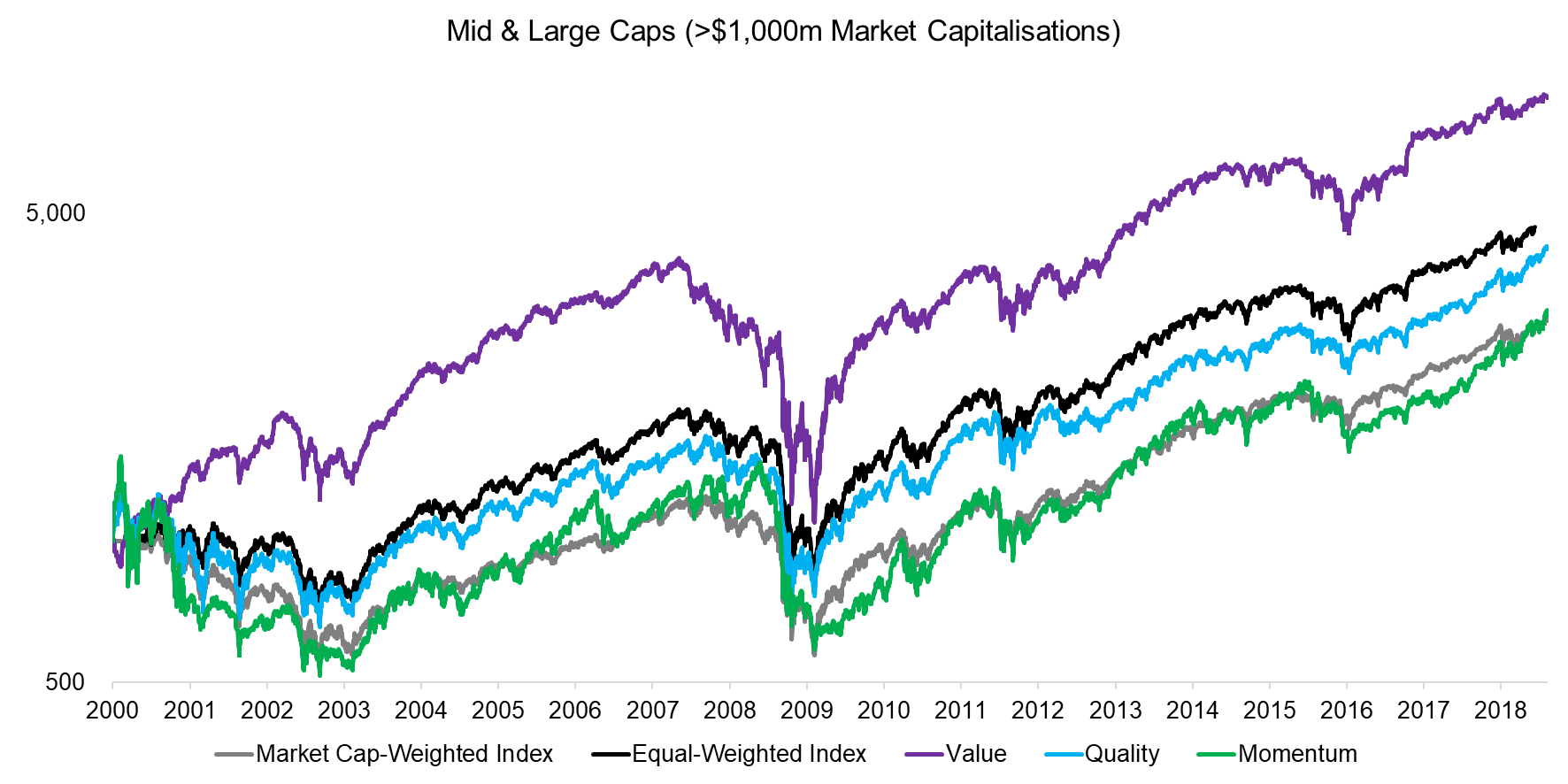
Source: FactorResearch
COMPARISON ACROSS MARKET CAP SEGMENTS
Analyzing the returns across the different market-cap segments yields the following takeaways:
- Index returns were highest for mid and large caps when weighted equally (EW), but highest for small caps when weighted by market cap (MW).
- Micro caps did not generate attractive returns at the index level regardless of the weighting methodology.
- CAGRS from the Value factor portfolio increased linearly with market capitalization. This is likely because the Value rebound after the tech bubble was stronger in mid and large caps.
- The Quality factor is most effective in micro caps, successfully screening out the deteriorating businesses.
- Momentum was impacted by the Momentum crash of 2009 across market cap segments.
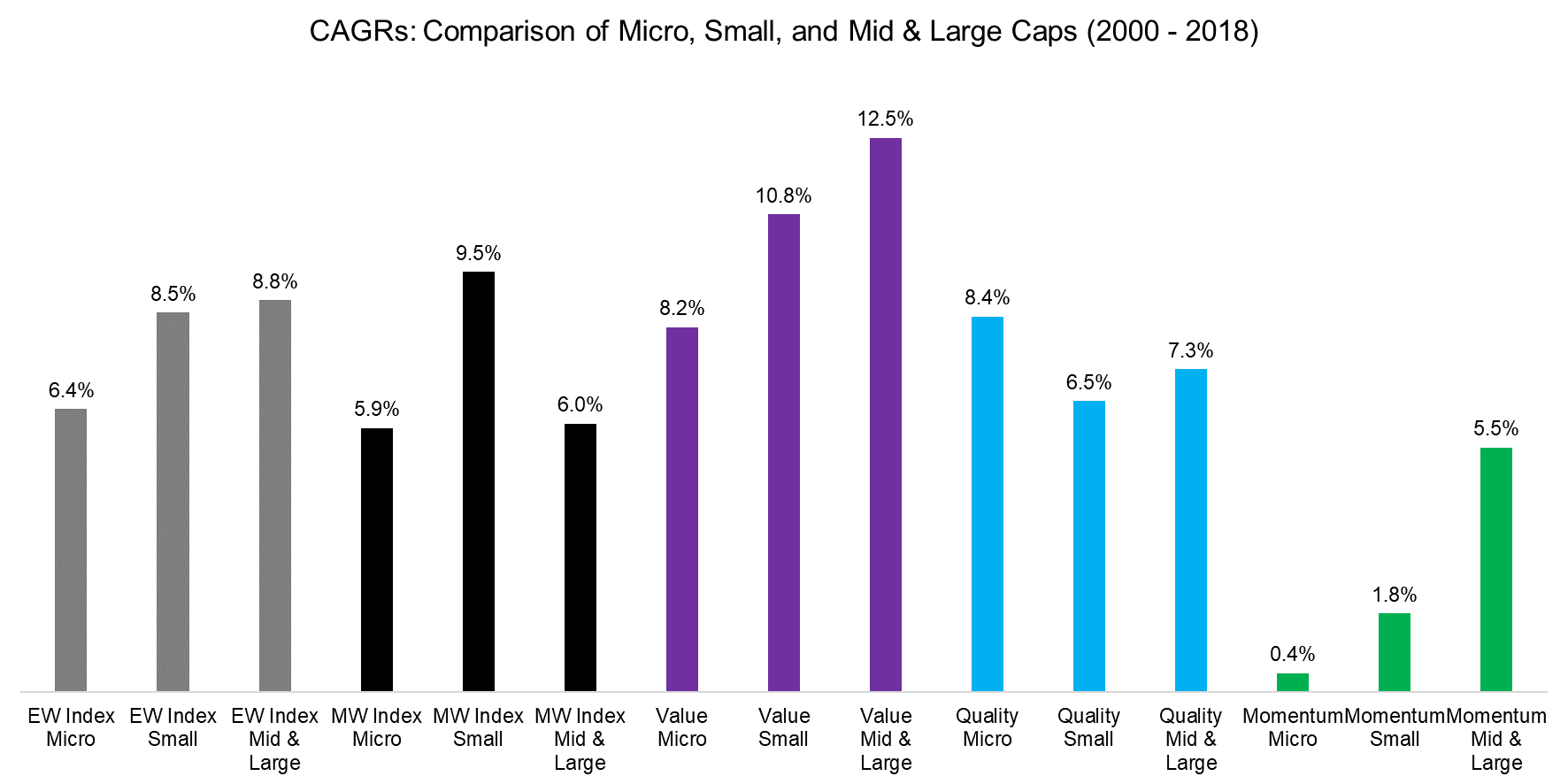
Source: FactorResearch
Returns can be normalized by transforming them into risk-return ratios. This demonstrates factor investing works just as well with mid and large caps as it does with small stocks.
Other researchers have shown that small caps generate the largest factor returns. Why do our results differ? Probably because we have different definitions of the market-cap segments, lookback periods, and transaction cost assumptions.
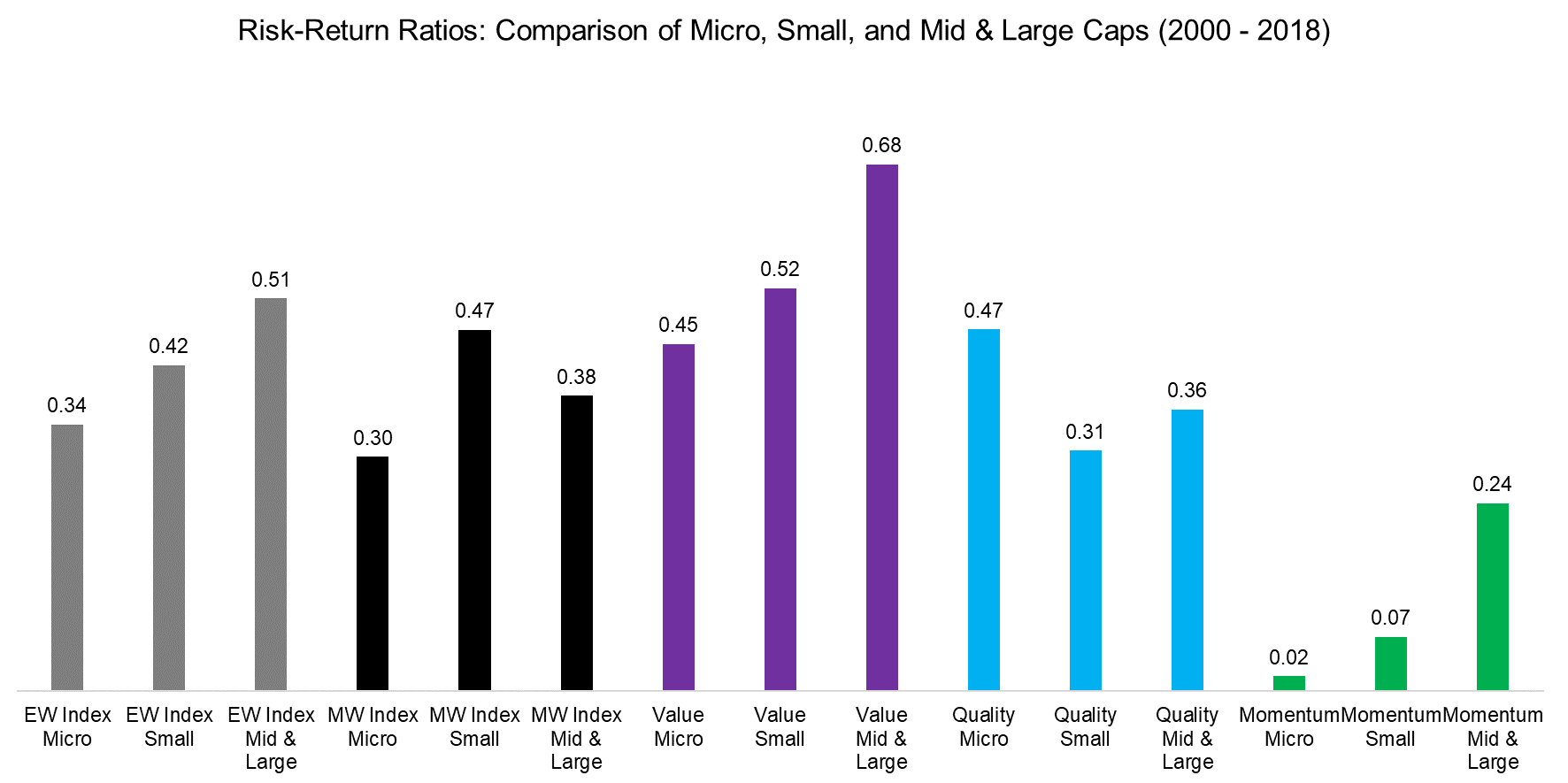
Source: FactorResearch
FURTHER THOUGHTS
Fortunately for most investors, our results demonstrate that factor returns are not exclusive to smaller companies.
So as alluring as they may be, US micro-caps — the Galaxy Gamings of the world — can safely be ignored.
RELATED RESEARCH
ABOUT THE AUTHOR
Nicolas Rabener is the CEO & Founder of Finominal, which empowers professional investors with data, technology, and research insights to improve their investment outcomes. Previously he created Jackdaw Capital, an award-winning quantitative hedge fund. Before that Nicolas worked at GIC and Citigroup in London and New York. Nicolas holds a Master of Finance from HHL Leipzig Graduate School of Management, is a CAIA charter holder, and enjoys endurance sports (Ironman & 100km Ultramarathon).
Connect with me on LinkedIn or X.

